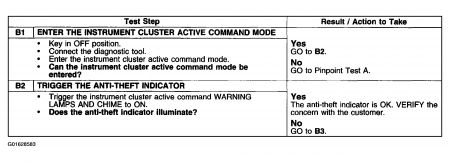The only way to reprogram is via fords diagnostic software .. there is no way of bypassing the PATS system i'm afraid !!
ANTI-THEFT-PASSIVE ANTI-THEFT SYSTEM (PATS)
The passive anti-theft system (PATS) contains the following components:
theft indicator
encoded ignition key
transceiver module
instrument cluster
powertrain control module (PCM)
standard corporate protocol (SCP) communication network
The PATS uses radio frequency identification technology to deter a driveaway theft. Passive means that it does not require any activity from the user. This system is known as SecuriLock(R) in North America, Safeguard(R) in the U.K. and PATS in continental Europe. This information can be found in owners literature.
The PATS uses a specially encoded ignition key. Each encoded ignition key contains a permanently installed electronic device called a transponder. Each transponder contains a unique electronic identification code, with over 72 million billion combinations.
Each encoded ignition key must be programmed into the vehicle's instrument cluster (the instrument cluster is also known as a hybrid electronic cluster [HEC]), before it can be used to start the engine. There are special diagnostic procedures outlined in the workshop manual that must be carried out if new encoded ignition keys are to be installed.
The encoded key is larger than a traditional ignition key. The key does not require batteries and should last the life of the vehicle.
The transceiver module communicates with the encoded ignition key. This module is located behind the steering column shroud and contains an antenna connected to a small electronics module. During each vehicle start sequence, the transceiver module reads the encoded ignition key identification code and sends the data to the instrument cluster.
The control functions are contained in the instrument cluster. This module carries out all of the PATS functions such as receiving the identification code from the encoded ignition key and controlling engine enable. The instrument cluster initiates the key interrogation sequence when the vehicle ignition switch is turned to RUN or START.
The PATS uses the PCM to enable or disable the engine. The instrument cluster communicates with the PCM over the SCP network in order to enable engine operation. The instrument cluster and the PCM use sophisticated messages in order to prevent a theft. The instrument cluster and the PCM share security data (when first installed together) that makes them a matched pair. After this security data sharing, these modules will not function in other vehicles. The shared PCM ID is remembered even if the battery is disconnected. The instrument cluster also stores the vehicle's key identification code even if the battery is disconnected. There are special diagnostic procedures outlined in this workshop manual that may be carried out if either a new instrument cluster or PCM needs to be installed.
All elements of PATS must be functional before the engine is allowed to start. If any of the components are not working correctly, the vehicle will not start.
PATS uses a visual theft indicator. This indicator will prove out for three seconds when the ignition switch is turned to RUN or START under normal operation. If there is a PATS problem, this indicator will either flash rapidly or glow steadily (for more than three seconds) when the ignition switch is turned to RUN or START. PATS also "blips" the theft indicator every two seconds at ignition OFF to act as a visual theft deterrent.

Wednesday, February 11th, 2009 AT 9:16 AM




